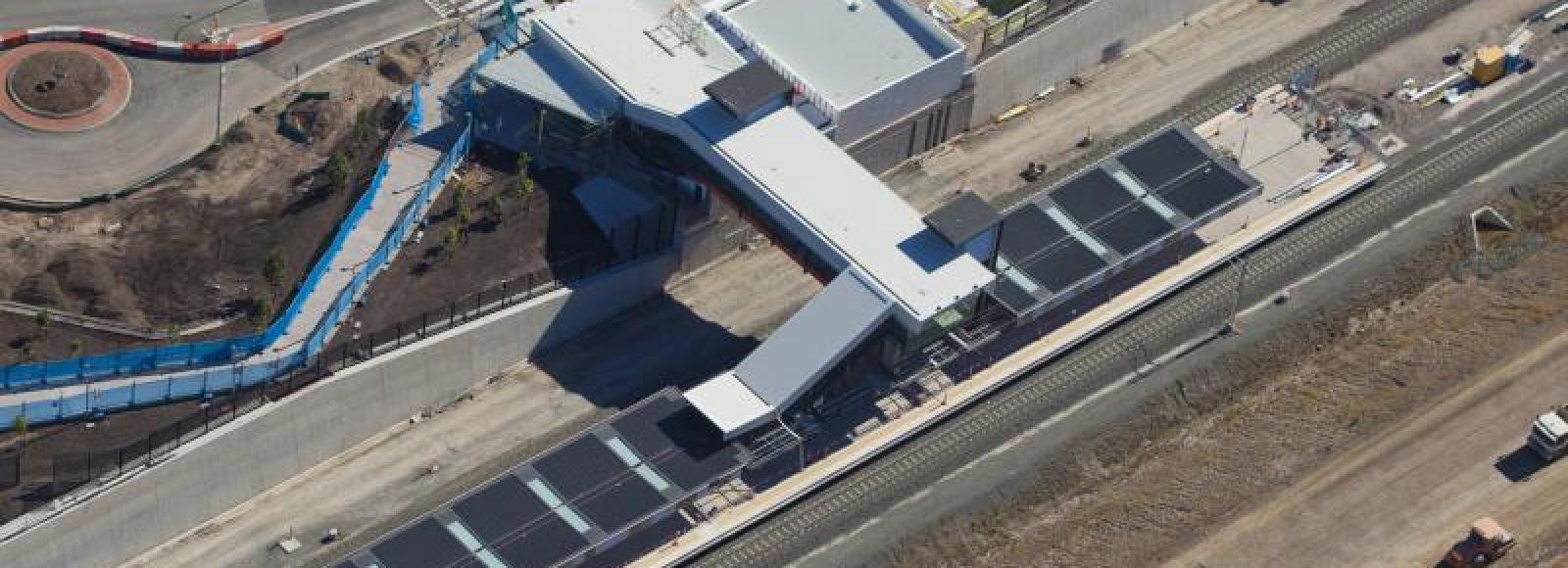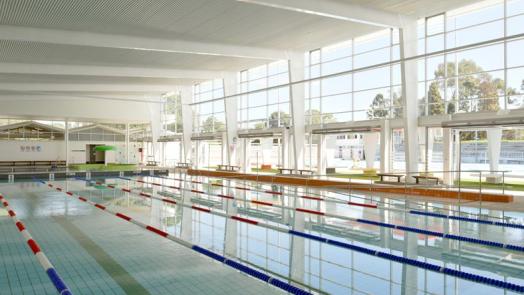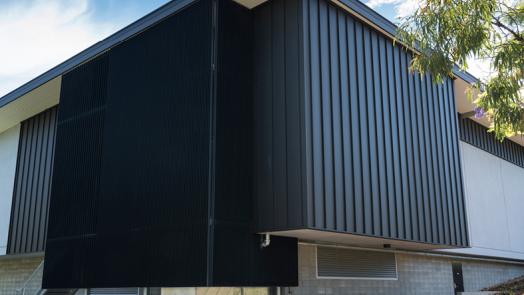
The Queensland Government’s $475 million Darra to Springfield Transport Corridor Stage 2 Richlands to Springfield Project is being delivered as an integrated road and rail project to provide key public transport infrastructure to support the expected population growth in the western corridor of Brisbane.
The project is seeing a 9.5 km dual track passenger rail line constructed between Richlands and Springfield, and two new stations at Springfield and Springfield Central.
LYSAGHT LONGLINE 305® profile was selected to clad the prominent roof and wall sections on the Springfield station complex, with nearly 1900 square metres of LYSAGHT LONGLINE 305® profile in both Monument® and Surfmist® COLORBOND® steel used to clad the central island rail platform and connecting pedestrian overpass bridge and service buildings.
100% Australian-made LYSAGHT LONGLINE 305® steel is a strong and durable, concealed-fixed cladding material suitable for roofing applications with a pitch as low as one degree.
The Queensland Government’s $475 million Darra to Springfield Transport Corridor Stage 2 Richlands to Springfield Project is being delivered as an integrated road and rail project to provide key public transport infrastructure to support the expected population growth in the western corridor of Brisbane.
The project is seeing a 9.5 km dual track passenger rail line constructed between Richlands and Springfield, and two new stations at Springfield and Springfield Central.
LYSAGHT LONGLINE 305® profile was selected to clad the prominent roof and wall sections on the Springfield station complex, with nearly 1900 square metres of LYSAGHT LONGLINE 305 profile in both Monument® & Surfmist® COLORBOND® steel used to clad the central island rail platform and connecting pedestrian overpass bridge and service buildings.
100% Australian-made LYSAGHT LONGLINE 305® steel is a strong and durable, concealed-fixed cladding material suitable for roofing applications with a pitch as low as one degree.
Its smart lines are created by narrow ribs and smooth pans. The distinctive profile adds interest to large areas by casting shadows which change throughout daylight hours.
Fixing is performed by the use of simple clips which are screwed to purlins. Watertight results are achieved because the clip method of fixing ensures that there are no holes to penetrate the sheet.
GCMR are one of Queensland’s leading roofing company’s providing high quality roofing solutions to major infrastructure, commercial, industrial, rail and retail projects and recently celebrated 10 years in business.
“I got my start in the roofing business pretty well the same as everyone else – on the tools,” explained Simon Vincent, Director of GCMR. “I was 27 years old and my first roofing job was on the Airlie Beach Shopping Centre and I was earning a whole $10/hour.
“But I did learn the basics there and I was able to spend the next few years travelling around Australia working as a roofing contractor and seeing the country.”
In 2003 after arriving back on the Gold Coast Simon decided to take the plunge for himself and started GCMR.
Right from the earliest days Simon was determined to set himself apart from other roofing companies in the market.
]“When I started GCMR I saw an opportunity to create a more professional roofing business,” said Simon. After many years in business GCMR gained a good reputation with many repeat clients and in recent times has been targeting Tier One projects. We have in place the systems, accreditations, procedures and policies that have enabled GCMR to meet the requirements demanded by the larger civil, commercial and government contractors.
In contrast to many other roofing businesses all GCMR staff are full time employees.
“Instead of sub-contracting our labour, as is the case with many roofing companies, we prefer to employ the best quality people and invest in their training and development so that we can deliver the best quality job,” explained Simon. “We have full time installation crews, administration staff, project managers, site supervisors and a full time safety officer.”
Lysaght have been supplying material to GCMR since day one and the Springfield Railway station is another in a long line of projects where they have worked together.
“We’ve had a strong relationship with Lysaght for 10 years now,” explained Simon. “With their long history in the Australian building industry and technical expertise we know we can rely on them to provide the support we need to get our job done.”
Brendon White, Lysaght’s Gold Coast Manager was equally keen to compliment the job done by GCMR on the Springfield Station.
“Architects seem to like the LYSAGHT LONGLINE 305® profile because it has a classy look that distinguishes it from other steel cladding profiles,” said Brendon. “But like any building material the end result comes down to the quality of the workmanship carried out and in this case GCMR’s team have done a great job with the installation.”
A design highlight of the Springfield station project was the use of “Mansard walls” which provide a visually seamless transition from roof to wall.
“Because of its high ribs achieving the mansard detail using LYSAGHT LONGLINE 305® can be tricky and requires a fair degree of skill and attention to detail,” explained Simon. “I’m really proud of the great job our crew did with the detailing of these joints.”
While the product is available nationally LYSAGHT LONGLINE 305® is currently only produced at Lysaght’s Emu Plains facility in Sydney.
This added some challenges to the project due to site storage limitations and access difficulties meaning that material had to be delivered to site only as it was needed.
Working closely with the GCMR’s project manager Lysaght received orders for their projected requirements two weeks out and produced the material in Sydney and shipped it to Queensland, scheduling it to arrive on site as it was needed.
“The team at Lysaght were great to work with,” said Simon. “Because of the project schedule and site restrictions we ended up needing eight separate deliveries of product over the 19 weeks it took to complete the project. Each time the material arrived exactly when it was needed, in perfect condition to go straight onto the roof. The Richlands to Springfield rail line is scheduled for completion in late 2013 and will provide a direct link between Springfield and Brisbane meaning better commuter access and less local congestion.


